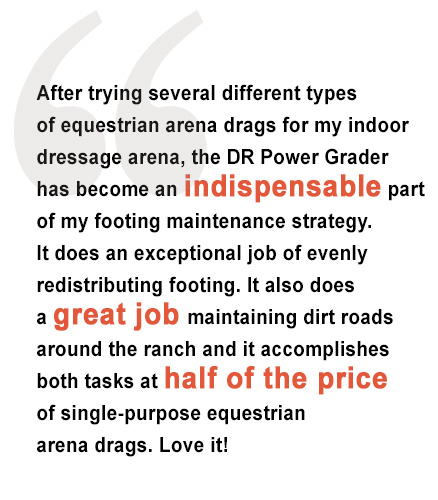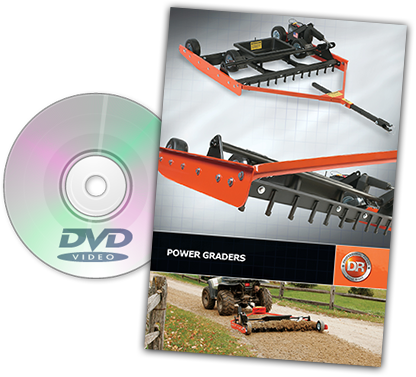Equestrian Arena Footing Maintenance: Arena Drag Comparison (Part 2/2)
Chris Diaz and his wife Verena own and manage Pferdehof Dressage, an equestrian facility in Berthoud, Colorado. They have years of experience maintaining professional riding arenas.
 Read part 1 of this article here.
Read part 1 of this article here.
There is no “one size fits all” approach to arena footing maintenance. Each arena drag has its own specific characteristics that make it more or less suited to a given arena type. The following comparison will describe these characteristics to help readers in the selection of an appropriate arena drag.
Chain Harrow
The Chain Harrow is by far the least expensive option and usually the first drag that a rookie arena owner will try. Chain harrows can be purchased for a few hundred dollars. They are essentially a mesh of metal bars that are spaced 6-8 inches apart combined with 2-3 inch tine hooks placedat several points on the mesh. Basically, a chain harrow is like taking a 6 foot section of chain link fence and dragging it around the arena. This is a “top-down” approach to maintaining the footing, Hoof prints will be smoothed out on the top of the surface but the chain harrow does very little to redestribute deep spots. Because it floats on top of the footing, it doesn’t collect enough material to effectively redistribute it. Chain harrows follow the contour of the arena. If the arena is even and level to start with, then a chainharrow will provide a nice finish and eliminate hoof prints. Over time however, the arena will invariably develop deep spots and shallow spots and will need to be leveled with some other approach.
Profiling Blade and Finishing Rake
A more sophisticated approach is using a drag that utilizes a profiling blade combined with a finishing rake. This is a more holistic design because it provides “top-down” and “bottom-up” benefits. Like the chain harrow, the finishing rake on this type of drag will smooth the surface of the footing and eliminate hoof prints providing the top-down maintenance. The profiling blade is a metal bar that rides below the surface of the footing and ideally rides along the base of the footing. This has a desirable effect of smoothing out bumps in the base layer of the footing. This is beneficial for situations where the arena has a soft dirt base that has become pocked by horses’ hooves punching through the surface footing and denting the base. This is less relevant in higher end arenas with a hard packed base layer. These drags move a fair amount of material when they are used which helps with redistribution but one common flaw in these drags is a fixed towing bar. This means that if the drag passes over a high spot in the footing, the ATV and the drag will rise which greatly diminishes the effectiveness of the profiling blade. The profiling blade essentially follows the surface of the footing rather than the base of the footing. These drags can also have the tendency to push material out towards the edges of the arena contributing to the bowl effect. These drags are a solid option but aren’t the most effective for redistributing deep spots which means that manual raking or some other leveling will need to be done. In terms of price, these drags are also among the most expensive options and typically cost >$3000.
Tow-Behind Grader
 A third approach is using a grader such as the DR Power Grader. This approach is often overlooked because people think they need to buy a special purpose arena drag. It turns out however, that the characteristics of a good grader are well suited to the needs of equestrian arenas as well. A grader incorporates a row of scarifying teeth at the front of the device and a grading blade at the rear of the unit. The scarifying teeth act like a comb running through the material making it light and fluffy which makes it easier to move when the grading blade passes over it. The grading blade then comes along and moves the material according to the contour of the base of the arena. This results in highly effective top-down and bottom-up redistribution of material. The grading blade can be raised and lowered with a convenient remote control so the rider doesn’t need to get on and off of the ATV to adjust the depth of the grader. This is important because depth adjustments will need to be made fairly frequently in the process. In deep spots, the grader is lowered and in shallow spots the grader can be raised. This technique yields precise control. As the ATV pulls the grader around the arena it will accumulate footing and spill it over the top of the blade. This effectively, knocks down deep spots and moves the extra material to the shallow spots. One other important design aspect of the DR grader is that it’s tow bar pivots allowing it to remain flat on the ground regardless of what the ATV is doing. This is a subtle concept but makes a big difference in performance. The design of the grader also allows it to do a great job on correcting bowl effect issues with the arena which is much easier than manual raking. The DR Power Grader is also typically about half the cost of special purpose arena drag alternatives.
A third approach is using a grader such as the DR Power Grader. This approach is often overlooked because people think they need to buy a special purpose arena drag. It turns out however, that the characteristics of a good grader are well suited to the needs of equestrian arenas as well. A grader incorporates a row of scarifying teeth at the front of the device and a grading blade at the rear of the unit. The scarifying teeth act like a comb running through the material making it light and fluffy which makes it easier to move when the grading blade passes over it. The grading blade then comes along and moves the material according to the contour of the base of the arena. This results in highly effective top-down and bottom-up redistribution of material. The grading blade can be raised and lowered with a convenient remote control so the rider doesn’t need to get on and off of the ATV to adjust the depth of the grader. This is important because depth adjustments will need to be made fairly frequently in the process. In deep spots, the grader is lowered and in shallow spots the grader can be raised. This technique yields precise control. As the ATV pulls the grader around the arena it will accumulate footing and spill it over the top of the blade. This effectively, knocks down deep spots and moves the extra material to the shallow spots. One other important design aspect of the DR grader is that it’s tow bar pivots allowing it to remain flat on the ground regardless of what the ATV is doing. This is a subtle concept but makes a big difference in performance. The design of the grader also allows it to do a great job on correcting bowl effect issues with the arena which is much easier than manual raking. The DR Power Grader is also typically about half the cost of special purpose arena drag alternatives.
In conclusion, there are lots of alternatives in the world of equestrian arena drags. The simple chain harrow simply doesn’t suffice in most cases. Special purpose arena drags are much better but can be quite expensive. The DR Power Grader provides an attractively priced option that delivers solid performance and is a multi-purpose implement that does a great job on maintaining dirt roads as well as maintaining high end equestrian arenas.
Chris Diaz, Owner Pferdehof Dressage
Berthoud, CO
www.PferdehofDressage.com
Want to learn more about DR Power Graders?
Order your FREE Buyer's Guide & DVD!

What's inside
- 24-Page Buyer's Guide
- Action-Packed DVD
- Money-Saving Promotions